See What You Look Like on Viva Lemon Fashion Magazine Cover
Graphic designers hear the term Swiss Design all the time. Yet nigh of us, if asked to define information technology, could do no ameliorate than point to a rather vague, general gestalt: crisp, blocky layouts, a minimalist design ethos, and sans serif typefaces.
Indeed, for many people, Swiss Design is basically synonymous with Helvetica—the very name of which in fact means "Swiss" (in Latin, Switzerland was the Confederatio Helvetica)—which was designed in 1957 and hit the market in 1960.

The importance of Helvetica cannot exist underestimated; the typeface is incessantly useful for everything from signage (look at the New York City subway, for example) to spider web pages to logos. Merely to really sympathise it, i must understand the greater tradition of Swiss Design.
In a nutshell, Swiss Blueprint was a movement that took agree in the 1950s in two Swiss art schools, the kunstgewerbeschule in Zurich, led past Josef Müller-Brockmann, and the Allgemeine Gewerbeschule in Basel, led by Armin Hofmann. Both of these instructors had studied with the great Ernst Keller in Zurich before World War II. These names volition become more than meaningful when we look at their work a little later.
Their style, which was called the International Typographic Style at the fourth dimension, was guided by the ethos that pattern should be every bit invisible as possible. All traces of the designer'south subjectivity should be suppressed in order to let the "content" of a work shine through. It is similar to the axiom of architectural modernism that grade should follow function.
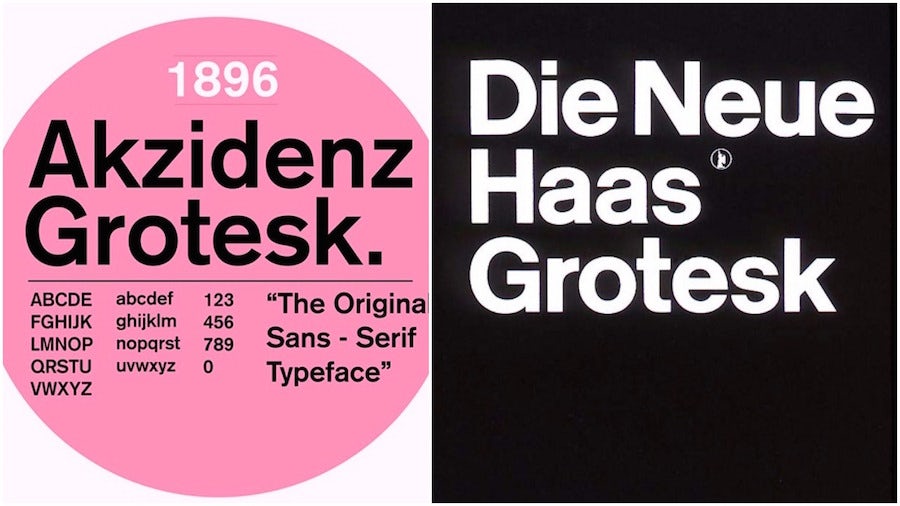
In practice, what distinguished Swiss Blueprint was the utilise of asymmetric layouts with text aligned flush-left, ragged-right; sans serif typefaces like Akzidenz Grotesk and, after, Helvetica (originally chosen Neue Haas Grotesk); the use of photographs instead of analogy; and, most importantly, the deployment of a mathematically determined grid to make up one's mind the placement of design elements—a method that remains extremely important to this twenty-four hour period in web blueprint.
Many of these features take become so prevalent in design that we no longer recall of them as distinctively Swiss. To get a sense of how distinctive they were at the time, nonetheless, permit's consider two American advertisements from the period—ane pre-Swiss Design, one post-Swiss Blueprint.
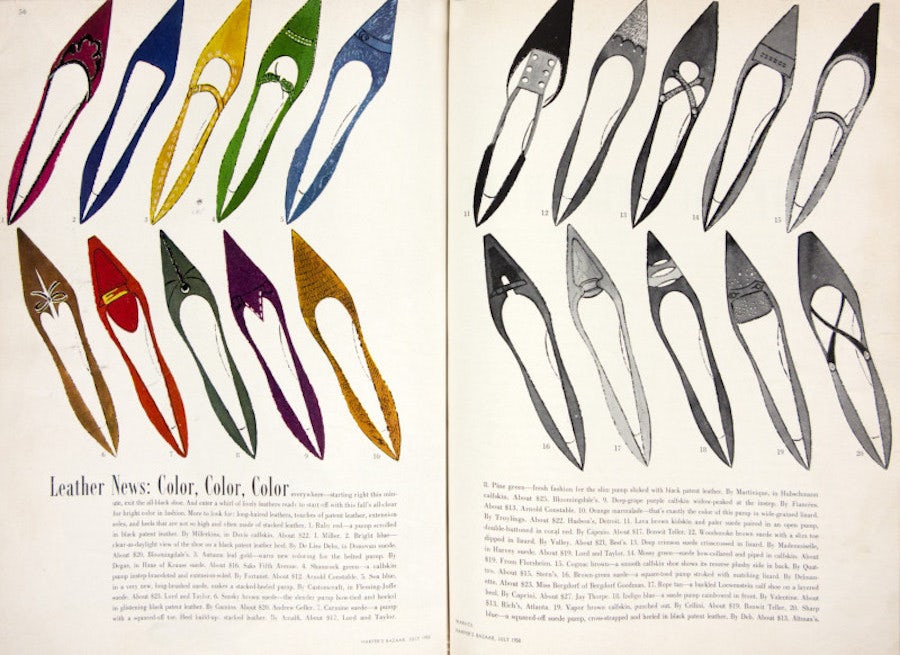
This 1952 magazine spread has one special thing almost it: the illustrator of the shoes is Andy Warhol, who would later become famous as a Pop creative person. But besides that, it is pretty representative of design standards of the time: the text is in a book-style serif font; it is justified both left and right to create symmetrical rectangles; and information technology is illustrated by drawings instead of photographs.
Now consider a dissimilar magazine page from about a decade later, afterwards the infuence of Swiss Blueprint had permeated the New York scene:

This iconic advertisement was designed by Helmut Krone, a New Yorker who was the son of German language immigrants, for the Manhattan design bureau Doyle Dane Bernbach. Without fifty-fifty getting to what makes the ad itself so vivid, consider the design elements lonely: here the illustration has become photographic and the typeface has become a sans serif. Overall, "pattern" in the traditional sense of the term has taken the backseat. The influence of the International Typographic Manner is clear.
At present nosotros accept a decent sense of what Swiss Design is. Simply the question remains, how did it develop, and why Switzerland? What's so special near the Alps? To understand these questions nosotros will need to commencement consider the blueprint and art movements that motivated and inspired Swiss Design (whether as a negative or positive example) and so take a closer look at the Swiss Design movement's specific protagonists and their accomplishments.
Design precedents
_
The birth of graphic blueprint as such can be dated to the 19th century, when "arts and crafts" and the "practical arts" commencement began to distinguish themselves from then-called "fine art" (i.e. painting, sculpture and compages) and plant contained institutions of study.
For any reason, this motility for the independence of design was strongest in the German speaking earth and the English speaking i. For a snapshot of its furnishings in the early on 20th century, nosotros tin consider 1 English language move, the Arts and Crafts, and i German language ane, the Jugendstil (or "youth way"). Swiss Blueprint was a reaction against both of these.
Arts and crafts

The Arts and Crafts motion in Britain was led past figures like William Morris. Morris believed that the mechanization of the industrial period had diminished the quality of craft work, and he urged a render to a Medieval model of artisanship.
His book designs like the one above are clearly pre-modern in season. They comprise tons of intricate patterns and illustrated particular.
Jugendstil
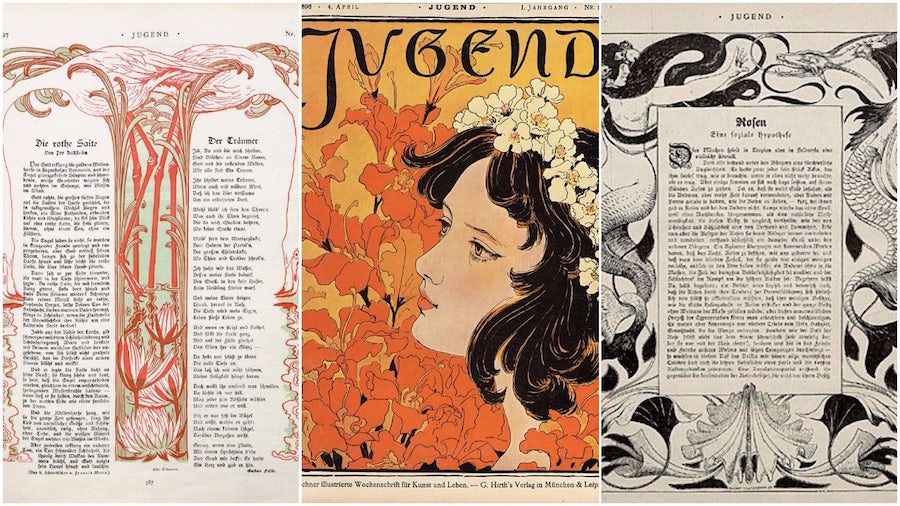
The Jugendstil, led by people similar Henri van de Velde and the typographer Otto Eckmann, is mostly seen as the Germanic equivalent of the Art Nouveau that reigned in French republic. It, too, is characterized past intricately manus-drawn floral motifs and pre-modern flourishes. Above all it was motivated by a want to exalt the subjectivity of the creative person or designer.
Swiss Design rejects such attempts to replicate the crafts of a pre-industrial guild and to privilege the subjectivity of the artist. Instead it embraces modernity and the clarity and anonymity of machine-based design.
Artistic inspiration
_
Swiss designers did non create this loftier-modernist arroyo out of nowhere. Rather, they looked to precedents at the intersection of art and blueprint from the flow spanning roughly 1914 and 1939. These included the movement of Suprematism and Constructivism in Russia, De Stijl in the Netherlands, and the Constructivism-inspired piece of work of the Bauhaus, a design school founded in 1919 in Dessau, Frg.
Russian Suprematism and Constructivism

Inspired by the 1917 revolutions, Russian artists like Kasimir Malevich and El Lissitzky sought to re-define fine art for coming socialist era. Their solutions, Suprematism and Constructivism, utilized simplified geometric forms and strong, sans-serif typography placed in unusual configurations.
De Stijl
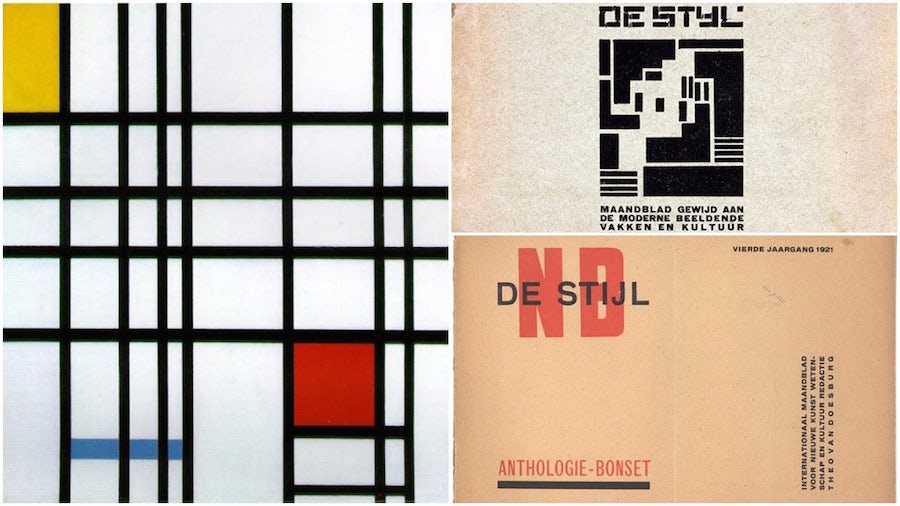
Meanwhile in The netherlands, artists like Theo von Doesburg and Piet Mondrian established a move that came to exist known as De Stijl (or simply "the style"). Spanning compages, painting and graphic blueprint, De Stijl's principles were rooted in mathematics and grid forms that served as compositional tools.
The Bauhaus

The Bauhaus was established to provide a wide ranging curriculum for the craft, but under the directorship of the architect Walter Gropius, information technology became specially oriented toward architectural modernism. In this environment, artists like Laszlo Moholy-Nagy pursued variants of constructivism that internalized elements of both Russian constructivism and De Stijl, including simple geometric shapes, sans serif typography and filigree arrangement.
Swiss innovations
_
Thus, all the ingredients of Swiss Blueprint were in place by World War Ii. Why did they happen to combine about fruitfully in Switzerland during the interwar and postwar periods? One possible explanation is the fact that Switzerland remained neutral during both conflicts. As a result information technology became a haven for intellectuals and a crossroads for ideas from many different places, from England and Holland to Germany and Russia.
Simply the evolution of Swiss Blueprint was more than than a unproblematic math equation. It resulted from the unique contributions of specific artists and designers whom we'll expect at here.
Ernst Keller

Ernst Keller is in many ways the grandfather of Swiss Pattern. He took a position at the School of Applied Arts in Zurich in 1918, and from at that place he instructed the leading lights of the next generation, among them Müller-Brockmann and Hofmann. While Keller'due south piece of work has a different flavor than what would come after, his preferences for striking graphics, irregular layouts and sans serif typefaces were all clearly influential.
Josef Müller-Brockmann

Müller-Brockmann was ane of the leading protagonists of Swiss Design in the 1950s. He is highly regarded for his posters, which use text, photographs and elementary graphics to create striking and rhythmic compositions. He is as well well known for his unswerving commitment to filigree-based design. In his own words:
"In my designs for posters, advertisements, brochures and exhibitions, subjectivity is suppressed in favour of a geometric grid that determines the organisation of the type and images. The filigree is an organisational organization that makes it easier to read the message…
The filigree is an organisational system that enables you lot to achieve an orderly result at a minimum cost. The job is solved more hands, faster and better."
(via Guity Novin)
Armin Hofmann

Over in Basel, Armin Hofmann was exploring a similar merely notwithstanding distinctive approach. His work gives even greater weight to typography and employs hitting tonal contrasts. Hoffman held a teaching appointment at Yale University in the mid 1950s, and was instrumental in bringing the Swiss mode to the U.s.a..
Adrian Frutiger
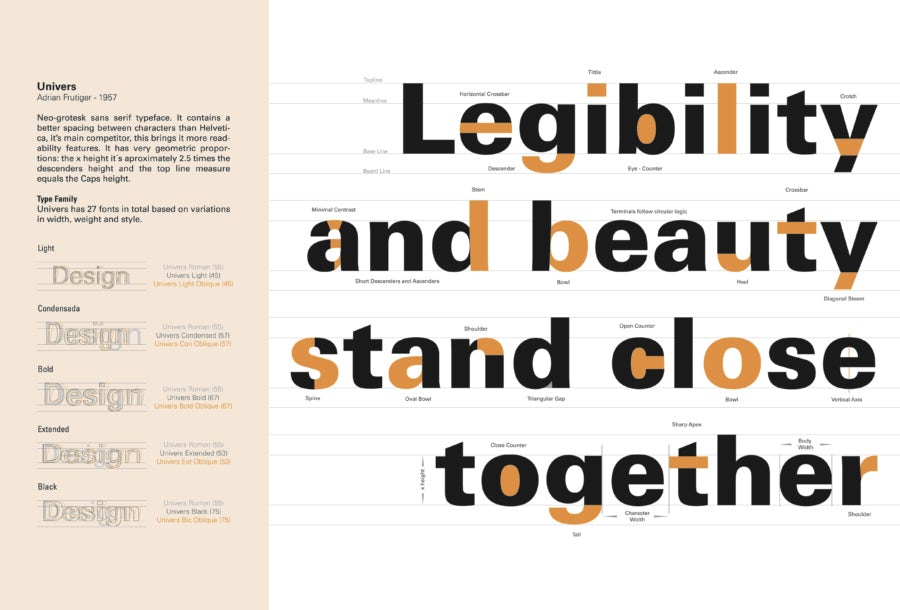
It is merely fitting to end this commodity on Swiss Pattern on a typographic note. Hevetica, which was designed by Eduard Hoffmann and Max Miedinger, is of course male monarch, and deserves all of the praise it receives. Merely instead we're going to look at its predecessor which was arguably more important: Univers.
Designed by Adrian Frutiger in 1954 and ultimately released in 1957, Univers is a sans-serif typeface that served to update the almost fifty yr one-time Akzidenz Grotesk. What made Univers such an important milestone is that information technology was the first megafamily typeface. Rather than coming in the usual three fonts—regular, italic and bold—it came in no fewer than 21 different weights, each labeled by a dissimilar number. This variety resulted in unprecedented flexibility for designers, who were at present able to design an entire project using various fonts of a single typeface, rather than having to apply a variety of typefaces in social club to go all of the weights they wanted.
This movement turned designers' attention to the possibilities of single typefaces in a completely new manner. The path to Helvetica and Swiss Design authorisation was set.
How do you incorporate the principles of Swiss Blueprint into your projects? Share in the comments!
Featured Image: "Musica Viva" by Josef Müller-Brockmann (via MOMA)
0 Response to "See What You Look Like on Viva Lemon Fashion Magazine Cover"
Post a Comment